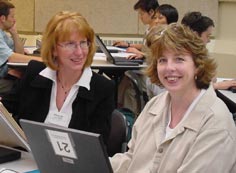 |
|
||||||||||||||||||||||||

|
Strategy 3: Integrating Language Modalities Language modalities (reading, writing, speaking, listening) should be integrated in curriculum units in a wide variety of genres (Cummins, 2000; Stoller, 2002; Tedick, 1998, 2003). In the CAPRII article, Tedick explains the rationale for integrating language modalities as follows:
A useful framework for considering how to integrate language modalities is embedded in the national Standards for Foreign Language Learning (1999). This framework is comprised of the three communicative modes that correspond to the first three standards—the interpersonal mode of communication (“two-way” interaction that typically involves negotiation of meaning), the interpretive mode of communication (“one-way” communication involving reading or listening), and the presentational mode of communication (“one-way” communication involving speaking or writing). [See also the CoBaLTT instructional module on the Standards.] Cooperative learning techniques lend themselves well to an integration of modalities. When students work together cooperatively, they have to speak and listen to each other and are frequently engaged in synthesizing information from sources (reading), taking notes (writing) and pulling together their ideas (writing) for later presentation (speaking/listening). Jigsaw is an especially effective cooperative learning technique. In a jigsaw activity, the teacher divides the class into “expert” groups (Kagan, 1989), who are assigned a section of a text to read for specific information. Then students “jigsaw”: they form a new “home” group with one person representing each of the original “expert” groups. Each student shares the information from the specific section read by their “expert” group. Roger Johnson, professor at the University of Minnesota , and internationally known for his work in the area of cooperative learning (Cooperative Learning Center), has developed a set of rules for teachers to facilitate jigsaw activities, which we call Roger’s Rules for Jigsaw. The cooperative benefits of the jigsaw activity are maximized when these rules are followed. Language modalities can be integrated within lessons and assessments more formally, but they might also be integrated informally to scaffold students’ language production. For example, some creative modifications of the common “think – pair – share” activity structure can maximize language use in all the modalities. Think – pair – share, first developed by Professor Frank Lyman and colleagues at the University of Maryland in 1981, is a very common activity structure used particularly in elementary classrooms. Met (2002) has developed an Expanded Think-Pair-Share for scaffolding oral language use by integrating multiple modalities. As Met’s diagram shows, during the think phase, students are encouraged to jot down words, phrases and ideas, or might be asked to complete part of a graphic organizer. They then partner with another student during the pair phase to practice and tell each other their ideas or read each other’s work and expand on the graphic organizer. Then, two pairs can join for “pair squared” where additional exchange and expansion of ideas can occur. During pair and pair squared phases, more writing can occur to prepare for the final sharing phase, where individuals report back on their group or pair work. These are but a few instructional ideas that
can be used to maximize language output and encourage the integration
of the language
modalities.
References: Cummins, J. (2000). Immersion Education for the Millennium: What we have learned from 30 years of research on second language immersion. http://www.iteachilearn.com/cummins/immersion2000.html [also online at CoBaLTT website]. Kagan, S. (1989). Cooperative learning: Resources for teachers. San Juan Capistrano, CA: Resources for Teachers. National Standards in Foreign Language Education Project. (1999). National standards for foreign language learning: Preparing for the 21 st century . Lawrence, KS: Allen Press, Inc. Stoller, F. (2002, March). Content-Based Instruction: A Shell for Language Teaching or a Framework for Strategic Language and Content Learning? Keynote presented at the annual meeting of Teachers of English to Speakers of Other Languages, Salt Lake City. [online at CoBaLTT website]. Tedick, D. J. (Ed.) (1998). Proficiency-oriented language instruction and assessment: A curriculum handbook for teachers. Minneapolis, MN: University of Minnesota. [for more information - /articulation/MNAP_handbook.html] Tedick, D. J. (2003). CAPRII: Key concepts to support standards-based and content-based second language instruction. CoBaLTT Web Resource Center. [online at CoBaLTT website]
|
||||||||||||||||||||||||